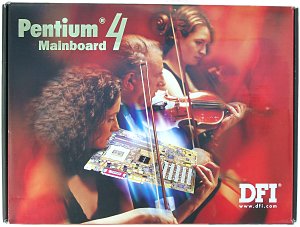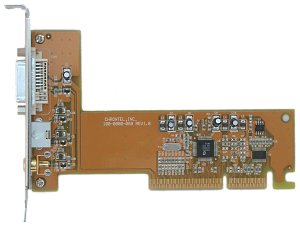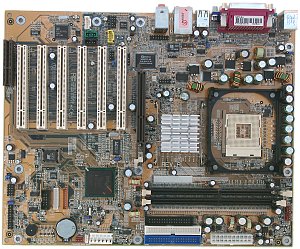DFI NB76-EA (i845G) Mainboard
|

Unlike all other boards on this chipset this one comes with
an ADD card. We have tested a preproduction sample.
Accessories:
- Package: a standard design;
- Documentation: a user manual in English;
- Cables: 1 ATA66/100/133, and 1 FDD;
- Bracket with COM and Game ports;
- ADD card with DVI, Composite and S-Video TV-Out;

- Reader for Smart and Secure Digital/Memory Stick cards;
- CD with software including:
- drivers;
- system monitoring utility;
- Boostek (changes FSB frequency from Windows);
- Software for the smart-card reader;
- DirectX 8.1.

The layout is generally good: only audio-ins are located between
the PCI slots. It can be difficult to reach some jumpers when the board is already
installed. Their functions are shown on the textolite.
The 3-channel switching voltage regulator incorporates 9 capacitors
of 2200 uF and several less capacious ones.
The following controllers are integrated:
- audio controller based on the Avance Logic ALC650 AC'97 codec with connectors
for front audio-outs and SPDIF;
- network controller based on the Realtek RTL8100BL chip supporting 10BaseT/
100BaseTX.
Thanks to the Winbond W83L518D I/O controller the board supports
(and has connectors for) readers of smart and SD/MS cards.
Non-unsoldered connectors: none.
The system monitoring is supported by the Winbond W83627HF-AW
chip. What is controlled:
- processor voltage (+1.5, +3.3, +5 and +/-12 V), VBAT and +5V Standby;
- speed of 3 fans;
- temperatures of the processor (a built-in sensor) and the board (a built-in
sensor).
There are 2 connectors for adjustable connection of fans and
1 for non-adjustable connection.
Brief characteristics of the board: memory slots - 2
DDR SDRAM; expansion slots - AGP/ 6 PCI/ CNR; I/O ports - 2 COM/ LPT/ 2 PS/2/
6 USB 2.0; dimensions - 305x245 mm.

Adjustment can be carried out with:
| jumpers and switches |
Jumper to clear up the CMOS |
 |
| Jumper to choose a FSB frequency |
100/133 MHz |
| Jumper to start up computer with a PS/2 keyboard |
 |
| Jumper to turn on computer with a USB keyboard |
 |
| Jumper to choose Standby voltage on the PCI slots |
3.3V or for expansion cards which do not comply with the PCI
2.2 standard |
| Jumper to choose a mode of the 6th USB port |
USB on CNR/ USB onboard |
| BIOS based on the 6.00PG version from Phoenix-Award |
Setup of memory timings |
+ |
CAS Latency, Active to Precharge Delay, RAS to CAS Delay, RAS
Precharge |
| Setup of memory frequency |
+ |
Auto, DDR200, DDR266 è DDR333 (DDR333 only at FSB=133 MHz set
with the jumper) |
| Setup of AGP bus |
+ |
 |
| Setup of PCI bus |
- |
 |
| Changeable scaler of AGP and PCI buses |
- |
 |
| Manual assignment of interrupts |
+ |
 |
| Changeable FSB frequency |
+ |
100-200 MHz in 1 MHz steps |
| Changeable CPU multiplier |
+ |
x8-x50 |
| Changeable core voltage |
+ |
1.1-1.85V in 0.025V steps |
| Changeable memory voltage |
- |
 |
| Changeable chipset voltage |
- |
 |
| Changeable AGP bus voltage |
- |
 |
We used the latest available version of the BIOS of 17/05/2002.
The board will be primarily interesting for home users who
do not play much, - it allows creating a real media combo device with a great
number of functions, but it implies that a user will deal exactly with the ADD
card supplied, not with a game video accelerator.
Test results:
Write a comment below. No registration needed!
|
|
 |
|
|
|




